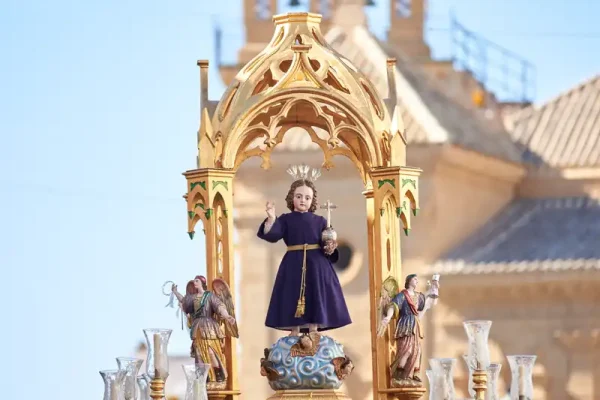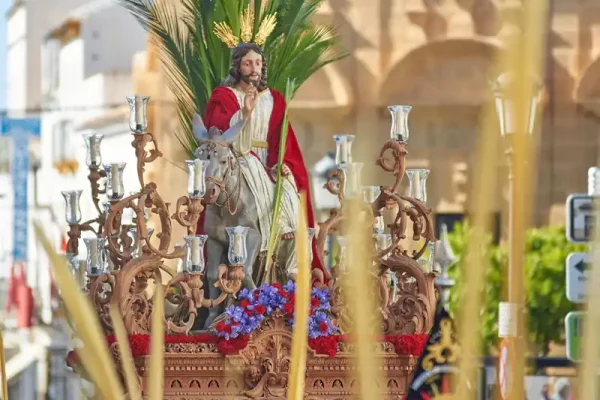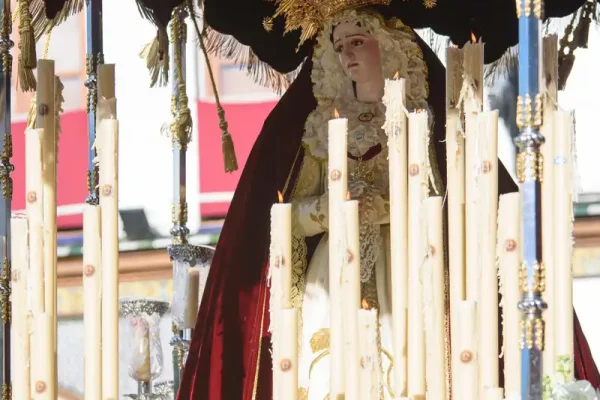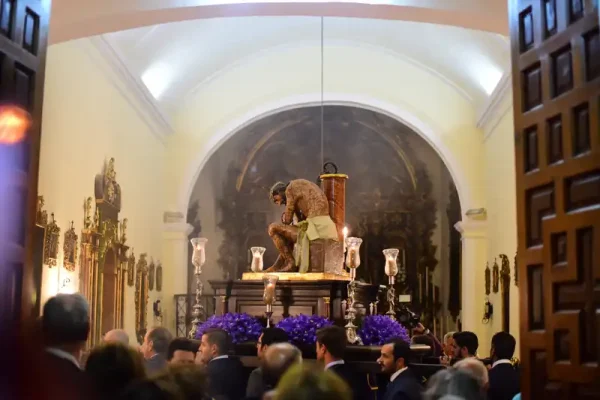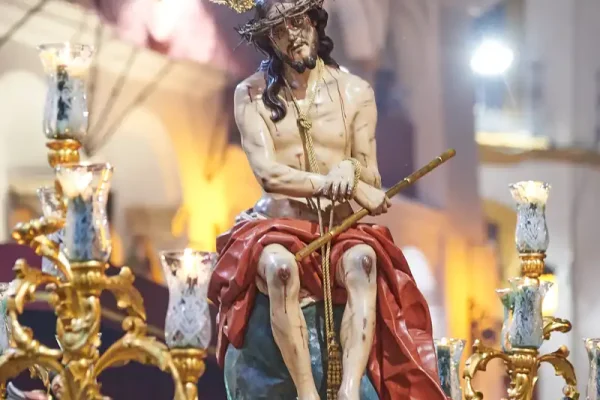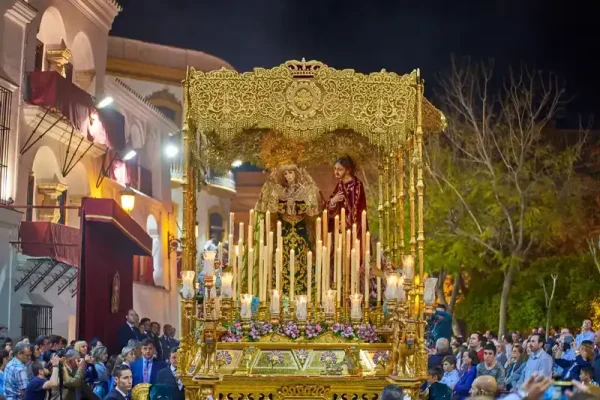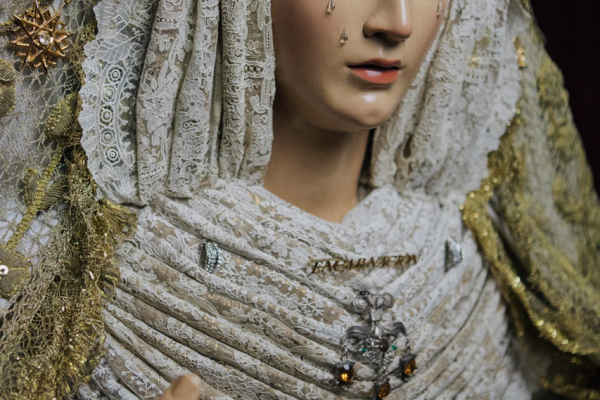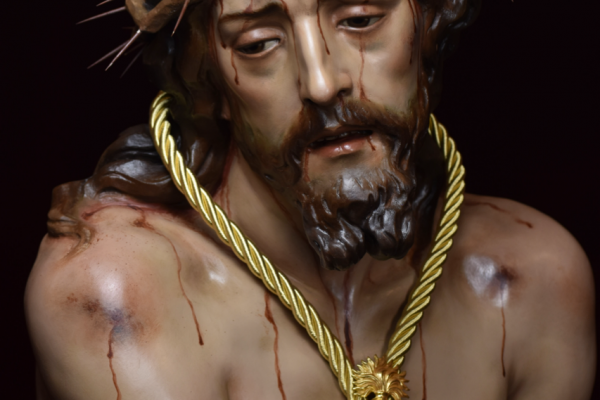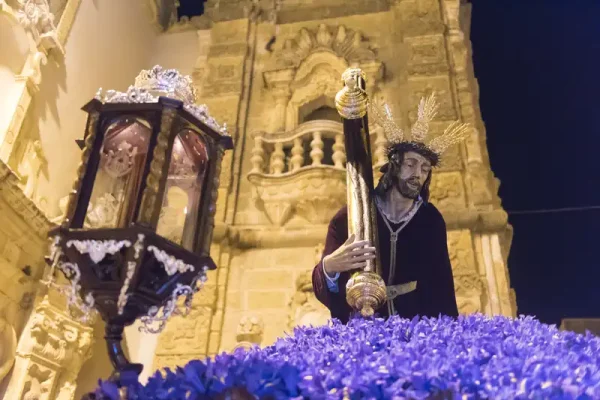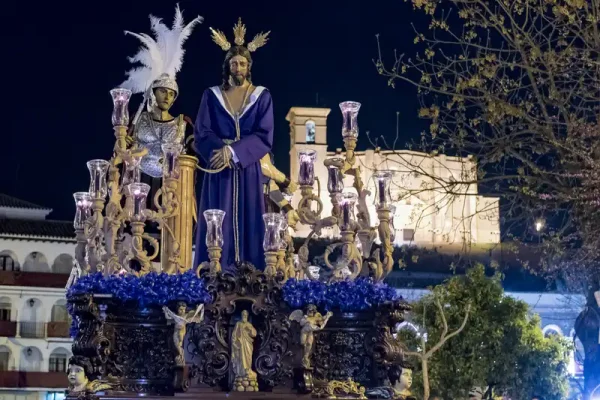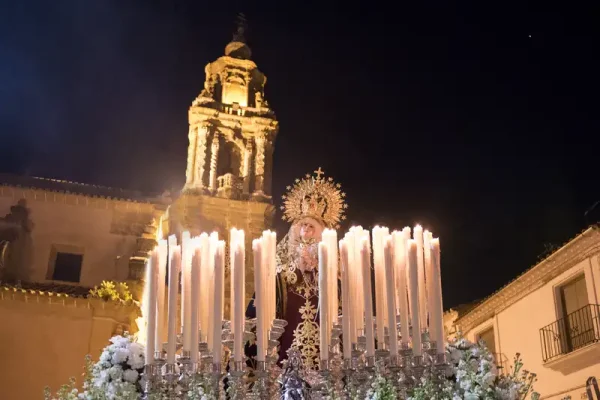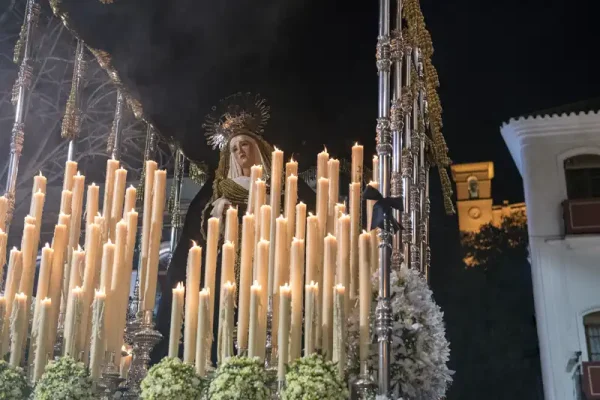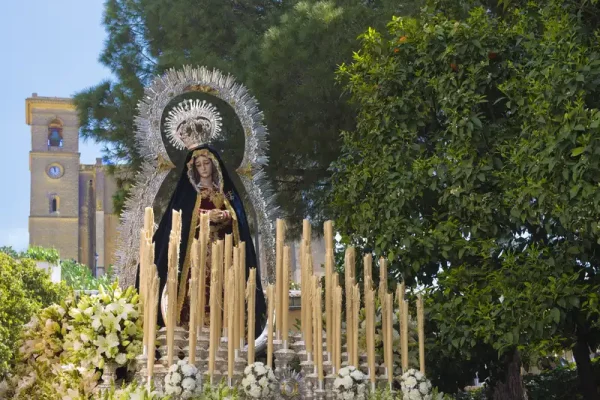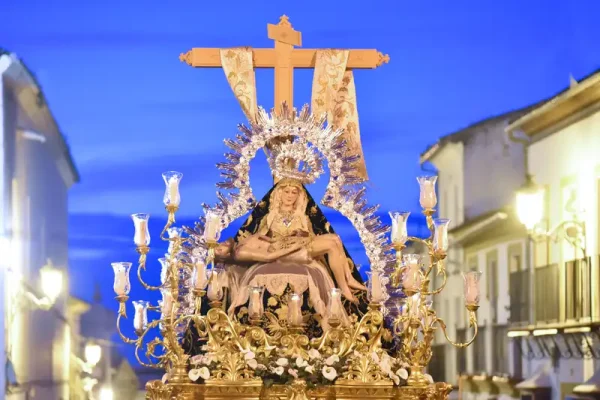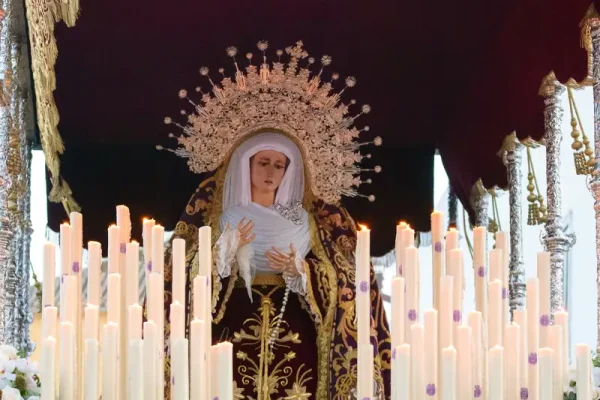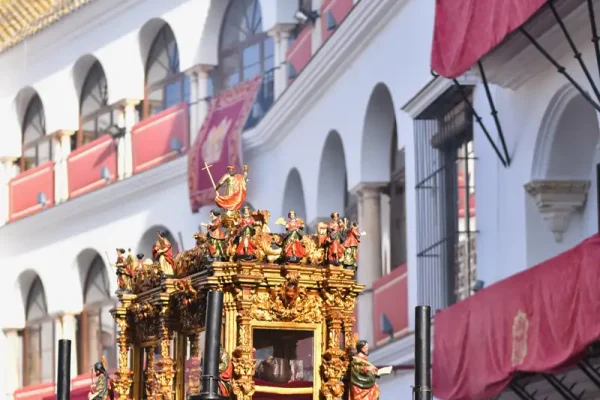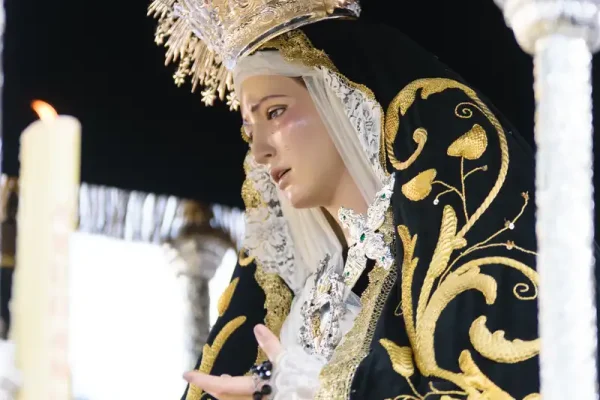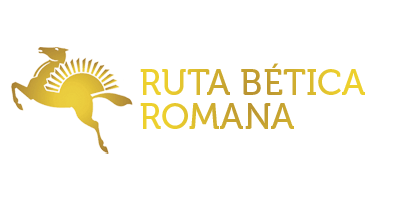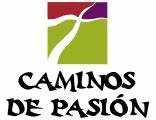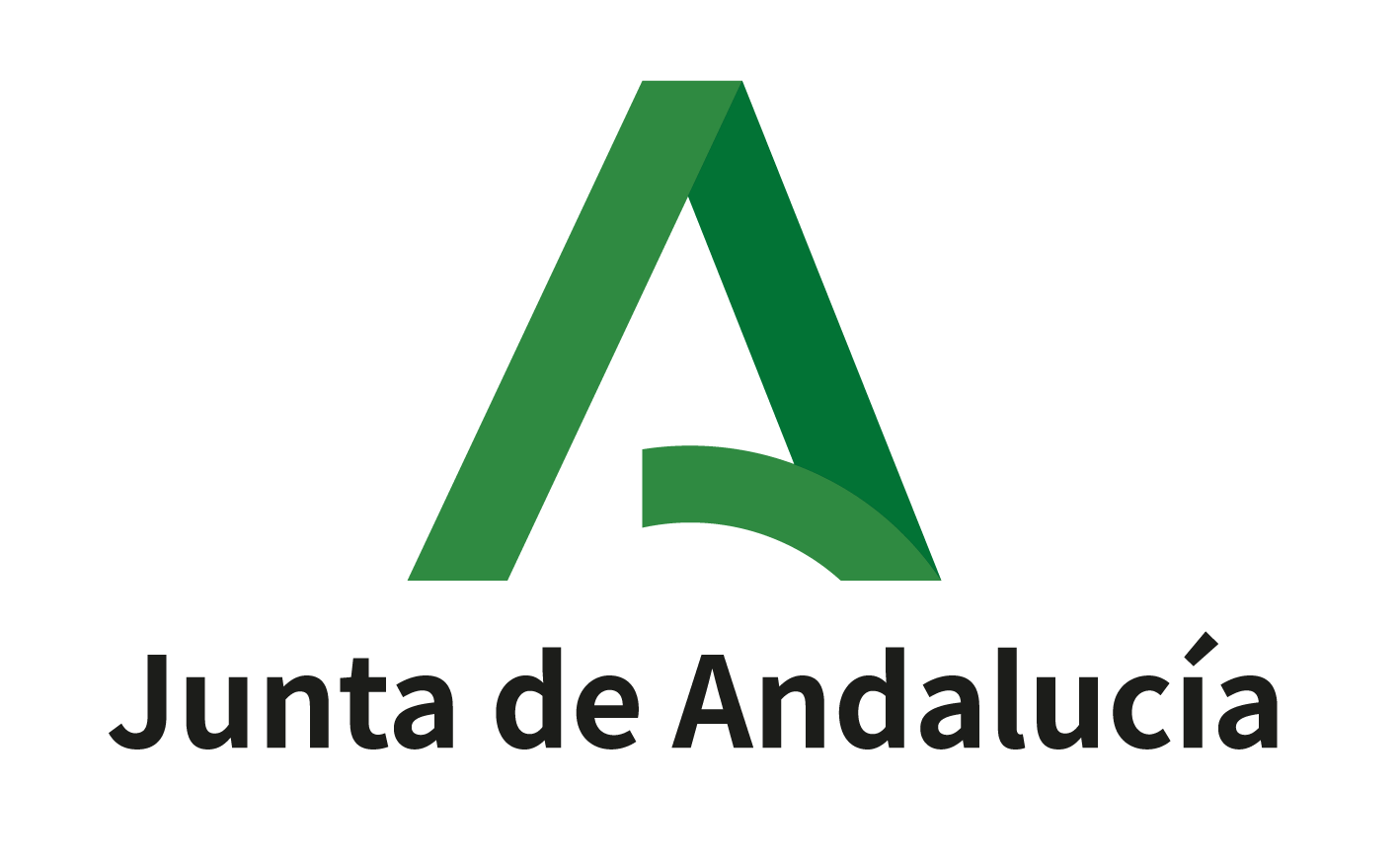


Palm Sunday
BROTHERHOOD OF THE SWEET NAME OF JESUS, TRIUMPHAL ENTRY OF JESUS INTO JERUSALEM AND OUR LADY OF THE FORLORNIt was founded on 7 March 1582, led by the Order of Preachers, and as a Brotherhood of Glory it only worshipped the image of Dulce Nombre. At the end of the 19th century, it became a Brotherhood of Penance and therefore purchased a Virgin of Sorrows, which they called Nuestra Señora de los Desamparados, making its processional exit on Palm Sunday. In 1960, the image of Jesus riding a donkey was commissioned, representing the Triumphal Entry of Jesus Christ into Jerusalem.
It currently leaves in procession from the Church of Santo Domingo, and there are three floats that make up this brotherhood: Dulce Nombre de Jesús, popularly known as ‘el Niño Perdido’ (the Lost Child), from the Seville School by an anonymous author from the late 15th century; Triunfal Entrada en Jerusalén (Triumphal Entry into Jerusalem), known as ‘La Borriquita’, from the second half of the 20th century, made in the workshops of Olot; and the Virgen de los Desamparados (Virgin of the Forsaken), attributed to Juan de Astorga from the 19th century. It should be noted that the traditional olive tree was replaced by a palm tree in the scene depicting Jesus' triumphal entry into Jerusalem.
Holy Monday
WAY OF THE CROSS OF OUR FATHER JESUS OF HUMILITY AND PATIENCEAccording to oral tradition, the ‘Royal and Carmelite Brotherhood and Confraternity of Nazarenes of Our Father Jesus of Humility and Patience, Christ Bound to the Column and Mary Most Holy of Solitude’ was founded by the guild of “Esparteros” (esparto weavers), a brotherhood popularly known as the Brotherhood of ‘Los Pellejos’ (the Hides), as some of the brothers wore a kind of leather boots that contained ointment to soothe the wounds suffered by the penitent brothers. The evening of Holy Monday was deserted until 2000, when the brotherhood carried out the successful restoration of its original patron saint, returning the sculpture to its former splendour.
The Christ of Humility and Patience depicts Christ, alone and forsaken, sitting on a small rock on Mount Calvary, waiting for the executioners to dig the hole where the cross of martyrdom will be planted. The iconographic origins of this theme are medieval and date back to the 14th century. However, the Christ of Humility, made of papier-mâché and glued fabric, is a work from the 16th century and after 1511, when the German artist Albrecht Dürer printed this dramatic scene on the cover of his famous and widely disseminated collection of woodcuts entitled ‘Small Passion’.
Dürer depicts Christ with one hand resting on his cheek, as does the artist who modelled the Christ of Humility in Osuna. We do not know his name, although he must have run a local workshop or one very close by, given the similar representations found in the nearby towns of Córdoba and Málaga. In 1964, this image was withdrawn from worship after suffering a huge storm on the afternoon of the Penitential Season, which left it quite damaged. From that moment on, it was kept in the Convent of the Carmelite Nuns, who acted as custodians of this image. For this reason and in gratitude, the Brotherhood transfers its original Patron Saint to the Convent of San Pedro, where it is worshipped throughout the week before Holy Week and from there, this brotherhood begins its Way of the Cross every Holy Monday.
Way of the Cross that passes through the streets of the neighbourhood, with the route being alternated by the brotherhood so that the image of the Lord may bless all the residents.
Holy Tuesday
ANCIENT AND HUMBLE BROTHERHOOD OF THE HOLY CHRIST OF THE TRUE CROSS, JESUS CAPTIVE AND OUR LADY OF HOPEThe Brotherhood of Santa Vera Cruz was founded in 1545 in the Franciscan convent of Madre de Dios, where it had its own chapel, attached to the Archbasilica of St. John Lateran in Rome. When the Franciscan temple collapsed in December 1944, it moved to the church of the former convent of St. Augustine, where it has had its canonical headquarters ever since.
The Cristo de la Vera Cruz is an anonymous work that can be dated to between the third and fourth decades of the 16th century. It is made of acana wood. It is carried in a Gothic-style procession, made at the end of the 19th century in the workshop of Hipólito Rossi, with which it composes a markedly romantic image. The sculpture of the Holy Ecce Homo del Portal, currently known as Nuestro Padre Jesús Cautivo, was made around 1765 by the Malaga sculptor Fernando Ortiz to preside over the main altarpiece of the convent of San Francisco. The full-length image of Nuestra Señora de la Esperanza, which replaced the original image dedicated to Nuestra Señora de la Soledad, was created, like that of San Juan Evangelista, by the Valencian sculptor Vicente Tena in 1901. Both images are carried in a procession on a float with a distinctly oriental style, made at the end of the 19th century, with a wooden vent and basket from which the figures of griffins and effigies protrude from the corners, popularly known as ‘La Virgen de los Perritos’ (Our Lady of the Little Dogs).
This brotherhood holds a procession from the Church of San Agustín, which is eagerly awaited by the townspeople. Of particular note are the numerous saetas (religious songs) that accompany the procession throughout its route and as it passes through the Plaza Mayor.
Every year, the Hermandad de la Vera-Cruz organises the Carmen Torres Saetas Competition and the Pregón de las Siete Palabras (Proclamation of the Seven Words) in collaboration with Osuna Town Council.
Holy Wednesday
BROTHERHOOD OF OUR LADY OF THE ROSARY AND FATIMA AND BROTHERHOOD OF OUR FATHER JESUS OF HEALTH AND MARY MOST HOLY OF THE INCARNATIONThe procession of Our Father Jesus of Health, created by Darío Fernández, will in future be a mystery scene featuring the Lord, Pontius Pilate, Claudia Procula, two Roman soldiers, a servant with a basin and Barabbas. Its first procession took place in 2024. Previously, Our Lady of the Incarnation was carried in procession on Passion Sunday.
Noteworthy features of María Stma. de la Encarnación include the burgundy velvet skirt embroidered in gold and the imperial blue velvet cloak with shell lace, as well as the sash with bow tie in Swarovski crystal, silver mesh and pearls.
This image of Mary was blessed on 10 January 2013 at the Monastery of the Incarnation and is the work of Javier Rojas Pouzols.
It makes its processional exit on Holy Wednesday from the Church of Our Lady of the Rosary of Fatima, and it is worth noting the exit and entrance, and its passage through the Plaza Reyes Católicos, where the neighbourhood of Fatima awaits.
Maundy Thursday
BROTHERHOOD OF THE HOLY CHRIST OF MERCY, OUR LADY OF PIETY AND SAINT JOHN THE EVANGELIST
The history of the brotherhood records that in 1723, on Holy Tuesday, due to a severe drought, the Christ of Mercy was carried in procession on the shoulders of the chaplains and returned to the Collegiate Church before nightfall. In 1928, the brotherhood was organised under its current name and its first rules were approved in 1929, with José Castro Maldonado as its senior member. At the time of its foundation, the Penitential Procession took place on Good Friday at three o'clock in the afternoon, then it was moved to Holy Thursday, also in the afternoon, before finally being moved to midnight on Holy Wednesday.
The image of Christ of Mercy was commissioned by the canon of the Collegiate Church, Diego de Ontiveros, from the sculptor Juan de Mesa in 1623. It is made of cedar wood and is an academic-sized carving.
Silence reigns throughout this brotherhood's procession, enveloping the day in a truly solemn atmosphere, which is why it is also known as the Brotherhood of Silence. For this reason, permission to participate is requested in writing and in silence.
ROYAL BROTHERHOOD OF PENITENCE AND HUMBLE MERCEDARIAN SLAVERY AND BROTHERHOOD OF NAZARENES OF THE DENIALS AND TEARS OF SAINT PETER AND OUR LADY AND MOTHER OF SORROWS
It was founded in the Church of La Merced by Manuel de Ávalos y Pimentel in 1705. In its early days, it was an eminently monastic brotherhood in which the Discalced Mercedarians played a key role both in its foundation and in its development. In 1964, due to the collapse of the Church of La Merced, they moved to Santo Domingo, where they remain to this day and from where they set out in procession.
The Brotherhood is formed by Our Father Jesus Caído, a polychrome cedar wood carving; its author is the Astigitano sculptor Alonso Gayón, dating from 1703. And Our Lady and Mother of Sorrows is an 18th-century candlestick image; it is an anonymous image, traditionally attributed to the Malaga-based sculptor Juan de Astorga. However, the latest attributions date it even further back. According to research carried out by José Luis Romero, it is attributed to the Malaga-based sculptor Salvador Gutiérrez de León.
ROYAL BROTHERHOOD AND CONFRATERNITIES OF NAZARENES OF OUR FATHER JESUS OF HUMILITY AND PATIENCE, CHRIST TIED TO THE COLUMN AND HOLY MARY OF SOLITUDE
According to oral tradition, it was founded in 1602 by the guild of ‘Esparteros’, a brotherhood of blood popularly known as the Brotherhood of ‘Pellejo’, as some brothers wore a kind of leather boots containing an ointment to soothe the wounds inflicted on the penitent brothers.
The brotherhood consists of three images: Our Father Jesus of Humility and Patience, an anonymous 16th-century work made of papier-mâché and glued fabric; Christ Tied to the Column, a work created between 1964 and 1965 by Antonio Izquierdo Benegas of Seville; and Holy Mary of Solitude, a work made of cedar wood in 1840 and attributed to Juan de Astorga.
The Christ of Humility and Patience is the original patron saint of the Brotherhood and the image that has been carried in procession during Holy Week in Osuna throughout the history of the Brotherhood until 1965, when it was withdrawn from worship due to deterioration. From that moment on, it was kept in the Convent of the Carmelite Nuns of Osuna, where it remained until 1998, when the Brotherhood decided to restore it. In gratitude to the Carmelite Mothers, the Brotherhood transferred its original patron saint to the Convent of San Pedro, where it is worshipped throughout the week prior to Holy Week and from where the Brotherhood begins its Way of the Cross every Holy Monday. The Way of the Cross passes through the streets of the neighbourhood, with the brotherhood alternating the route so that the image of the Lord blesses all the residents. As a substitute for the Christ of Humility, they commissioned the image of Christ tied to the column.
The departure point is the Carmelite Convent Church.
Good Friday
FERVENT BROTHERHOOD OF OUR FATHER JESUS OF NAZARETHIt was founded in the last quarter of the 16th century, more specifically on 8 July 1576, and has remained in the same location ever since, the former school of Nuestra Señora de la Victoria of the Order of Saint Francis of Paola. Its first rules date from a year later.
It currently has a total of 1,283 members, making it the penitential station that brings together the most faithful among the Nazarenes with candles and penitents with crosses. It carries a Baroque-style image of the Nazarene, by an anonymous artist, but it has always been attributed to the School of Pedro Roldán ‘El Mozo’. Its artistic quality and the serene expression on its face have always been praised, a compendium of mystical sweetness that serenely accepts the destiny of the Redeeming Cross.
Highlight the climb up the Cuesta de San Antón and the Plaza de la Encarnación.
SACRAMENTAL BROTHERHOOD AND VENERABLE THIRD ORDER OF SERVANTS OF OUR MOTHER AND LADY OF SORROWS
In 1719, the patent for the establishment of the Venerable Third Order of the Servants of Mary of Osuna was issued from the Valencian convent of Santo Sepulcro de Quart. However, it was not until 1730 that it was founded in the College of the Minims of the Victory of the Servite Slavery of Our Mother and Lady of Sorrows. The following year, the community of the Mínimos ceded the use of the chapel. The image is attributed to José de Mora from the late 17th or early 18th century. It is a full-length carving, with the cloak and skirt embroidered with rich floral and geometric motifs. Her hands are clasped together, holding her heart pierced by seven daggers.
It makes its processional exit from the Church of La Victoria in the early hours of Friday morning, and we would highlight this sister's climb up the Cuesta de San Antón and the Plaza de la Encarnación.
ANCIENT, VENERABLE AND FERVENT BROTHERHOOD AND CONFRATERNITY OF NAZARENO OF OUR LADY AND MOTHER OF THE FIFTH ANGUISH
To study the origins of this ancient Ursaonense brotherhood, we are fortunate to have preserved the original copy of the founding rule, which is unique in our town. It was founded in the Convent of the Holy Spirit on 30 October 1580. Shortly afterwards, on 3 December, it moved to its historic headquarters in the Convent of San Francisco. The brotherhood has been based in several churches (the Church of Santo Domingo and the Church of Santa Clara) due to the misfortune of collapses. It currently has its canonical headquarters in the Parish Church of La Victoria. The carving of the Virgin is by an anonymous artist and dates from the foundation of the Brotherhood, and the image of Christ was replaced by the current one from the Illanes workshops in 1934. These two images form an interesting iconographic version.
As a peculiarity, this brotherhood carries more than 400 calla lilies collected by the neighbourhood residents as part of its traditional floral decoration, and this beautiful image of piety is carried through the streets of our town in darkness.
BROTHERHOOD OF THE HOLY CHRIST OF PEACE AND MARY MOST HOLY OF GREAT SORROW
Perteneciente a la parroquia de Nuestra Señora de la Consolación, la cofradía fue fundada el 4 de abril de 1653. Desde la fecha de su fundación hasta 1836, estuvo regida por los religiosos frailes de la Tercera Orden Penitencial de Nuestro Seráfico Padre San Francisco de Asís. El primer libro de reglas perteneciente a la cofradía data de 1940 y fue recopilado por fray Carlos María Martín Gil, del Convento del Carmen de Osuna.
The Cristo de la Paz is a Gothic sculpture dating from the 16th century by an anonymous artist. The image depicts Christ dead with his head slumped to the right side. It is a crucifix with a marked triangular outline, as it is attached to the cross by three nails. The Virgen del Mayor Dolor is a complete sculpture with a beautiful face, also by an unknown artist; it has a very pearly polychrome finish.
Holy Saturday
BROTHERHOOD OF THE HOLY BURIAL OF OUR LORD JESUS CHRIST IN THE MYSTERY OF HIS DEATH AND RESURRECTION, MARY MOST HOLY IN HER SOLITUDE AND BITTERNESS, TRIUMPH OF THE HOLY CROSS AND OUR LADY OF THE HEADIt was founded by the Marquis of La Gomera as a family brotherhood, and its original name was Cofradía de Nuestra Señora de la Cabeza (Brotherhood of Our Lady of the Head). Since its foundation, it has made very few processions, the last one being in 1696. Since its foundation, it has been located in the Church of the Dominican Convent in a Baroque chapel bearing the name of this brotherhood, until the closure of the convent for restoration. Its revitalisation began in early 1993 and its first penitential procession took place in 2000. Currently, this brotherhood is located in the Church of San Carlos el Real, carrying out its procession from the Church of Santa Clara.
This brotherhood carries three floats in its procession: the image of the Recumbent Christ, anonymous, dating from before 1715, with the urn being a gilded carving by José de Cueto and Juan Pineda between 1824 and 1828; the image of Our Lady, created in 2008 by the sculptor Marcos Antonio Humanes; and the Triumph of the Holy Cross, popularly known as ‘La Canina’.
As a peculiarity, the canopy's knocker depicts the towers of San Carlos el Real and Santo Domingo, highlighting an image of Our Lady of the Assumption.

